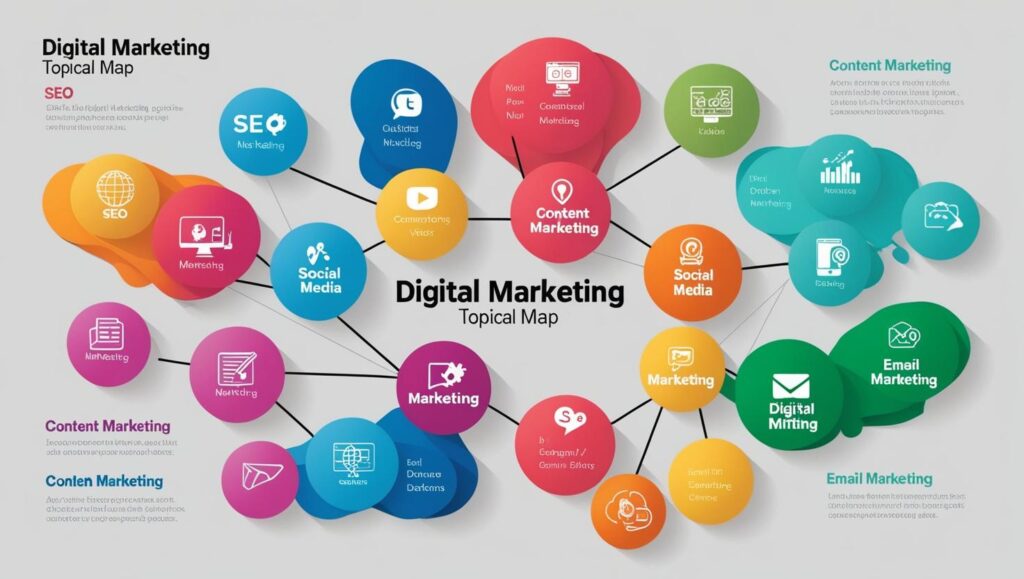
In the ever-evolving world of digital marketing, every brand is chasing the elusive formula for going viral. Whether it’s a clever tweet, a captivating video, or a blog post that explodes with shares, there’s usually more to the story than luck. Behind these viral sensations lies a strategic foundation that many overlook—the topical map is The Secret Weapon Behind Viral Digital Marketing Campaigns. If you’ve never heard of it, buckle up. This secret weapon might change the way you do digital marketing forever. In Digitlents Academy, we offer the best digital marketing courses in Bangalore. join us and master in Digital Marketing Course.
What Is a Topical Map?

Let’s start with the basics. A topical map is a strategic content framework that organizes your digital marketing topics into interconnected clusters. Think of it like a roadmap for your content. It ensures you’re covering every angle of a subject, building authority, and helping search engines understand your site’s relevance in a particular niche.
Unlike simple keyword research, which often focuses on individual search terms, topical mapping looks at the entire ecosystem of a subject. It helps you connect the dots between related content, making your site more comprehensive—and more irresistible to both users and search engines.
Why Viral Campaigns Need Structure Behind the Scenes
Here’s the truth: viral campaigns aren’t born from chaos. They’re engineered with purpose. When a campaign goes viral, it usually aligns with a bigger content strategy. And that’s where topical maps shine and The Secret Weapon Behind Viral Digital Marketing Campaigns.
A solid topical map allows you to:
- Anticipate user intent.
- Provide exhaustive, value-rich content.
- Improve SEO performance.
- Increase internal linking (great for user retention and SEO).
All of these benefits lead to greater organic visibility, which is the foundation of viral potential.
The Psychology Behind Virality
Before diving deeper into strategy, let’s touch on what makes content go viral in the first place. There are a few key psychological triggers:
- Emotional impact: Content that stirs emotion (joy, anger, surprise) is more likely to be shared.
- Relatability: People share content that reflects their identity or beliefs.
- Social currency: Sharing smart or entertaining content boosts our perceived value.
- Practical value: Helpful how-tos and guides get shared like crazy.
Now imagine combining all of these triggers into a strategically mapped content plan. That’s not just smart—that’s powerful.
How Topical Maps Boost SEO (And Help You Rank Higher)
SEO is no longer just about stuffing keywords into blog posts. Search engines have become much more sophisticated, and topical authority is now a major ranking factor.
Here’s how topical maps support SEO:
- They help you build content clusters that signal expertise.
- They allow better use of semantic SEO, covering related terms naturally.
- They improve crawlability and internal linking, aiding search engine bots.
- They support E-E-A-T (Experience, Expertise, Authority, and Trust) signals.
When your website covers a topic comprehensively, search engines are more likely to view you as a trusted source—making it easier for your content to rank and spread.
Building a Topical Map: Step-by-Step Guide
1. Start With a Core Topic
Choose a main subject that aligns with your niche. This will be your pillar or cornerstone content. For example, if you’re in the wellness industry, your core topic might be “holistic health.”
2. Identify Subtopics
Break down your core topic into clusters. These should be related yet distinct areas that fall under your main topic. Using our example, subtopics might include:
- Natural remedies
- Nutrition and diet
- Meditation techniques
- Alternative therapies
3. Research Questions and Keywords
Use tools like Google’s “People Also Ask,” AnswerThePublic, or Semrush to find the questions people are asking. Then, identify long-tail keywords and semantically related phrases.
4. Map It Out Visually
Use a content mapping tool (or even a simple mind map) to visually connect your pillar content with subtopics and related blog posts. This helps ensure nothing gets missed.
5. Create Internal Linking Paths
Once your content is live, interlink your pages strategically. Your pillar page should link out to all cluster pages, and vice versa.
Topical Maps vs. Traditional Keyword Strategy
Here’s a side-by-side comparison to illustrate the difference:
| Traditional Keyword Strategy | Topical Mapping |
| Focuses on individual keywords | Focuses on entire topic ecosystems |
| May lead to fragmented content | Encourages cohesive, structured content |
| Reactive based on volume trends | Proactive and strategic |
| Often lacks depth or connection | Builds authority through comprehensive coverage |
The takeaway? While keyword research is still essential, topical mapping provides the strategic backbone that turns random efforts into a winning content machine.
Real-World Example: Topical Mapping in Action
Let’s say you run a digital marketing agency specializing in email marketing. Here’s how a simple topical map could look:
Core Topic: Email Marketing
Clusters:
- Email list building
- A/B testing
- Email automation
- Cold email outreach
- Copywriting for emails
- Email deliverability
- Metrics and KPIs
Each of these clusters can support multiple blog posts, tutorials, case studies, and tools. You’re not just writing articles—you’re building a content fortress that Google and your audience will love.
How Topical Mapping Fuels Social Media Virality
Viral content often starts with discoverability—and discoverability starts with SEO. Once your content ranks, it’s more likely to get shared. But there’s more.
By having a structured map, you can:
- Repurpose each piece into bite-sized content for social platforms.
- Tell a consistent story across blog posts, videos, and graphics.
- Create a content series that builds anticipation.
- Drive traffic from one platform to another (cross-promotion magic!).
All of this increases content reach, encourages engagement, and boosts the chances of something going viral.
Mistakes to Avoid When Using a Topical Map
While topical mapping is powerful, it’s easy to go off track. Here are a few pitfalls to watch for:
- Too broad or vague topics: Specificity is key to authority.
- Ignoring user intent: You must understand what your audience actually wants.
- No interlinking: Without links, your map is just a list.
- Inconsistent content quality: Every piece must deliver real value.
Tools to Help You Build a Better Topical Map
You don’t have to do it all manually. Here are some tools that can help:
- Surfer SEO – Great for content clustering and keyword analysis.
- MarketMuse – AI-powered topical authority builder.
- Frase.io – Helps you plan and optimize content around questions and topics.
- MindMeister or Miro – Perfect for visual mapping.
These tools won’t do the work for you, but they’ll make it a whole lot easier.
Conclusion: Topical Mapping Is Your Secret Weapon
In a digital world full of content noise, being strategic and structured gives you the edge. Topical mapping isn’t just about SEO—it’s about crafting content that connects, converts, and compels people to share.join Digitalents Academy as we offer Best Digital Marketing Courses in bangalore and master the Digital Marketing Course.
The Secret Weapon Behind Viral Digital Marketing Campaigns is don’t leave it to chance. Start with a solid topical map, focus on user intent, and let the magic unfold. It’s time to turn your content into a powerhouse of engagement and visibility—one well-planned topic at a time.
